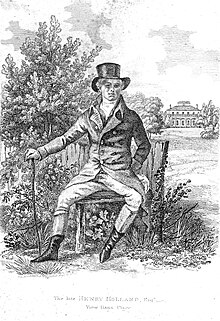Sloane Place

Sloane Place, later The Pavilion, was a large house built by the architect Henry Holland in Knightsbridge, London, and located immediately to the south of Hans Place.[1]
In 1774, Holland leased 100 acres of what had been nursery gardens from Lord Cadogan, to redevelop as housing, including Hans Place, keeping 21 acres to build a property for himself.[1]
Sloane Place was built in 1780, and Holland had moved in by 1789.[1][2] There were hothouses, a vinery, fruit trees, a Gothic ice-house on the west side of a lawn and a ruined castle/priory.[2][1]
Holland died there in 1806, after which it was sold on to Peter Denys,[1][3] who renamed it The Pavilion, and died there in 1816.[4] It was later subdivided, before being demolished in 1874.[1] The site of the house is now occupied by Shafto Mews[1] and is memorialised by Pavilion Road.
References[edit]
- ^ a b c d e f g Hans Town: Conservation Area Proposals Statement (PDF). Royal Borough of Kensington and Chelsea. 2000. p. 16-18. Retrieved 4 March 2019.
- ^ a b "Settlement and building: From 1680 to 1865, Hans Town - British History Online". www.british-history.ac.uk. Retrieved 4 March 2019.
- ^ John Britton; Edward Wedlake Brayley (1816). The Beauties of England and Wales, Or, Delineations, Topographical, Historical, and Descriptive, of Each County. Thomas Maiden. p. 57.
- ^ The New Monthly Magazine. 1816. p. 72.
